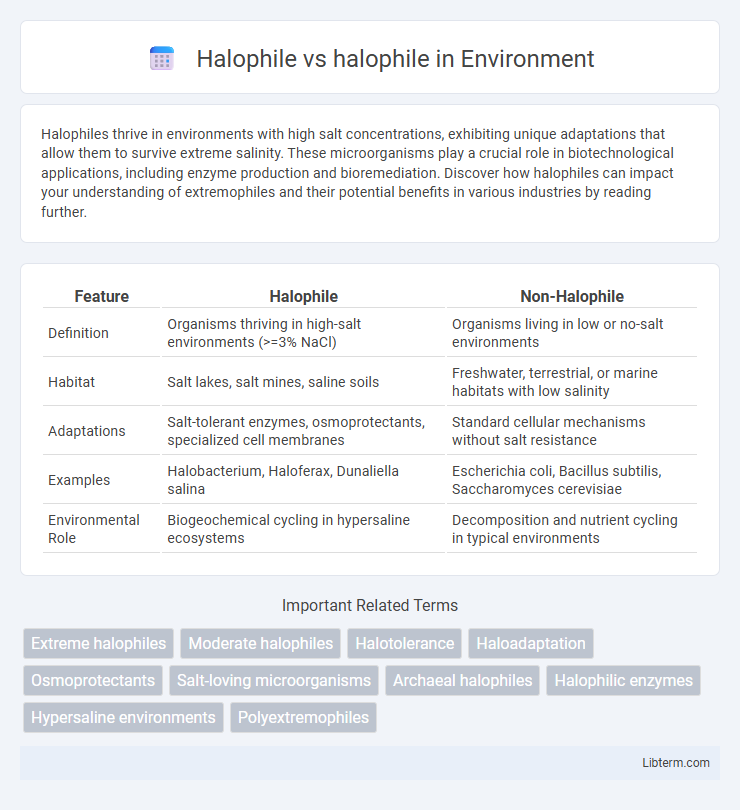Halophiles thrive in environments with high salt concentrations, exhibiting unique adaptations that allow them to survive extreme salinity. These microorganisms play a crucial role in biotechnological applications, including enzyme production and bioremediation. Discover how halophiles can impact your understanding of extremophiles and their potential benefits in various industries by reading further.
Table of Comparison
| Feature | Halophile | Non-Halophile |
|---|---|---|
| Definition | Organisms thriving in high-salt environments (>=3% NaCl) | Organisms living in low or no-salt environments |
| Habitat | Salt lakes, salt mines, saline soils | Freshwater, terrestrial, or marine habitats with low salinity |
| Adaptations | Salt-tolerant enzymes, osmoprotectants, specialized cell membranes | Standard cellular mechanisms without salt resistance |
| Examples | Halobacterium, Haloferax, Dunaliella salina | Escherichia coli, Bacillus subtilis, Saccharomyces cerevisiae |
| Environmental Role | Biogeochemical cycling in hypersaline ecosystems | Decomposition and nutrient cycling in typical environments |
Introduction to Halophiles
Halophiles are microorganisms that thrive in environments with high salt concentrations, such as salt lakes, saline soils, and salted foods, showcasing remarkable adaptations to osmotic stress. These extremophiles belong primarily to the Archaea domain but are also found among Bacteria and Eukaryotes, with species like Halobacterium and Halococcus representing classic examples. Their unique proteins, compatible solutes, and specialized ion pumps enable cellular function and stability in hypersaline conditions, making halophiles valuable for biotechnological applications and studies of extremophile life.
Defining Halophile: Scientific Overview
Halophiles are extremophilic microorganisms that thrive in environments with high salt concentrations, typically above 3% sodium chloride. These organisms adapt through unique cellular mechanisms, such as accumulating compatible solutes and specialized ion pumps, enabling survival and growth in hypersaline habitats like salt lakes and saline soils. Understanding halophiles provides insights into molecular adaptations and biotechnological applications in enzyme production and bioremediation under saline conditions.
Types of Halophiles: Classification and Diversity
Halophiles are microorganisms that thrive in environments with high salt concentrations, and they are classified into three primary types based on their optimal salt tolerance: slight halophiles (1-5% NaCl), moderate halophiles (5-20% NaCl), and extreme halophiles (20-30% NaCl). This classification reflects the diversity within halophiles, spanning various domains including Archaea, Bacteria, and some Eukaryotes, each adapted to different hypersaline habitats such as salt lakes, saline soils, and salted foods. The extreme halophiles, often belonging to the family Halobacteriaceae, exhibit unique physiological and molecular adaptations, like specialized ion pumps and compatible solutes, enabling survival in highly saline environments.
Environmental Adaptations of Halophiles
Halophiles exhibit exceptional environmental adaptations that allow them to thrive in high-salinity habitats, such as salt lakes, saline soils, and salt mines. These microorganisms maintain osmotic balance through the accumulation of compatible solutes like potassium ions and specialized proteins that stabilize cellular structures against salt-induced denaturation. Their unique membrane lipid composition and efficient DNA repair mechanisms enable survival under extreme salinity and intense UV radiation typical of hypersaline environments.
Halophile Metabolism and Salt Tolerance Mechanisms
Halophiles exhibit specialized metabolism adapted to hypersaline environments, often relying on aerobic respiration and unique enzymes stable in high salt concentrations to efficiently generate energy. Their salt tolerance mechanisms include the accumulation of compatible solutes like potassium chloride and the presence of salt-adapted proteins that maintain cellular function and structural integrity in extreme salinity. These adaptations enable halophiles to thrive in environments with salt concentrations ranging from 15% to over 30%, far exceeding the tolerance of non-halophile microorganisms.
Halophile Habitats: From Salt Lakes to Salt Mines
Halophiles thrive in extreme hypersaline environments, ranging from natural salt lakes like the Dead Sea to man-made salt mines deep underground. These microorganisms adapt to high salinity by maintaining osmotic balance and producing specialized proteins, enabling survival in environments with salt concentrations often exceeding 20%. Halophile habitats represent unique ecological niches that support diverse microbial communities essential for biogeochemical cycles in hypersaline ecosystems.
Halophiles in Biotechnology and Industry
Halophiles are microorganisms that thrive in high-salt environments, exhibiting unique enzymes and metabolic pathways suited for extreme conditions. In biotechnology and industry, halophiles are exploited for the production of salt-tolerant enzymes, bioplastics, and compatible solutes, which have applications in pharmaceuticals, food processing, and environmental bioremediation. Their stability and activity in hypersaline and low-water environments make halophilic biomolecules valuable for industrial processes requiring high salt concentrations or osmotic stress.
Comparative Analysis: Extreme vs Moderate Halophiles
Extreme halophiles thrive in environments with salt concentrations above 20%, such as the Dead Sea, utilizing specialized proteins and cellular mechanisms to maintain osmotic balance and avoid dehydration. Moderate halophiles prefer salt concentrations between 3% and 15%, inhabiting environments like marine waters and saline soils, and exhibit flexible salt tolerance allowing survival in fluctuating salinities. This comparative analysis highlights the distinct adaptive strategies and ecological niches of extreme versus moderate halophiles, emphasizing their roles in biotechnological applications and environmental resilience.
Halophiles and Human Health Implications
Halophiles, a category of extremophilic microorganisms thriving in high-salt environments, hold significant roles in biotechnology and human health due to their unique enzymes and metabolites. These organisms contribute to the production of bioactive compounds with potential therapeutic applications, including antimicrobial and antioxidant properties that may influence disease prevention and treatment. Studying halophiles enhances understanding of microbial adaptation mechanisms and offers promising avenues for developing novel pharmaceuticals and probiotics aimed at improving human health.
Future Research Directions for Halophile Studies
Future research directions in halophile studies emphasize unraveling the genetic mechanisms underlying extreme salt tolerance to engineer robust microbial strains for biotechnological applications. Advances in metagenomics and proteomics aim to discover novel biomolecules with industrial and pharmaceutical potential from diverse hypersaline environments. Exploring halophile interactions within microbial communities could enhance understanding of ecosystem dynamics and resilience under increasing salinity due to climate change.
Halophile Infographic

 libterm.com
libterm.com